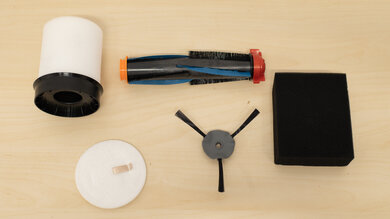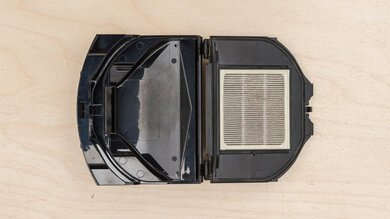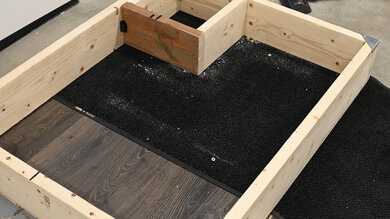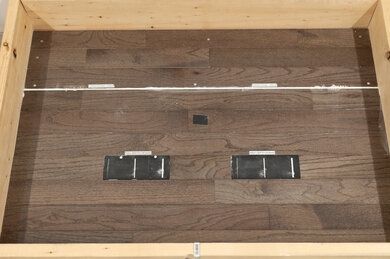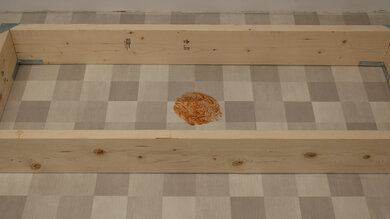The Shark Matrix Robot is a mid-range robot vacuum. It sits above the Shark EZ Robot Self-Empty in the brand's lineup, from which it differentiates itself with the inclusion of a LIDAR sensor, which allows for handy features like pin-and-go navigation and support for virtually-drawn no-go zones. It's also compatible with a self-emptying base station, helping to reduce hands-on maintenance requirements. However, unlike pricier models in the lineup, it lacks any sort of 2-in-1 functionality, so you'll need to look elsewhere if you want a hybrid robot vacuum/mop.
Our Verdict
The Shark Matrix Robot delivers inadequate performance in households with multiple floor surfaces. It's good on bare floors but much worse on carpet, where it struggles with fine material and does an especially poor job along edges and in corners. Its brushroll isn't very effective on pet hair—hair gets tangled in the brushroll, and a lot gets left behind. The vacuum has poor obstacle avoidance as well. The self-emptying docking station, while convenient, has its problems too, with a tiny dirt compartment that's messy to empty. The robot vacuum has no mopping system, so it's unable to tackle stains.
- Self-emptying capability.
Good performance on bare floors.
Struggles with pet hair on carpet as it tangles in its brushroll.
Poor obstacle avoidance.
- No mopping capability.
Docking station requires frequent emptying and is messy to maintain.
The Shark Matrix Robot is a poor choice for pet owners. It struggles with pet hair on carpets, quickly getting hair tangled in its brushroll. It won't be able to avoid pet waste due to its poor obstacle avoidance, and its lack of a mopping system means it can't clean stains. Its many parts will require frequent cleaning, and while its bagless self-emptying docking station helps, emptying the docking station's dirt compartment will likely release dust and pet hair. On the upside, it runs very quietly, which is good if your pet is particularly sensitive to loud noises.
- Self-emptying capability.
- Quiet operation.
Struggles with pet hair on carpet as it tangles in its brushroll.
Poor obstacle avoidance.
- No mopping capability.
- Has many parts that need periodic cleaning.
Docking station requires frequent emptying and is messy to maintain.
The Shark Matrix Robot offers good performance on hard floors. It easily cleans up medium and large debris but leaves some fine debris along wall edges and in corners.
Good performance on bare floors.
The Shark Matrix Robot does a disappointing job on carpet. It has difficulty picking up fine debris, leaving much of it behind. It also leaves a lot of material along edges and in corners.
Poor performance picking up fine material from carpet.
Has difficulty cleaning along carpet edges and in corners.
The Shark Matrix Robot is inadequate for cleaning up pet hair. It picks up some loose pet hair sitting on top of carpet, but presses a lot of pet hair in rather than sucking it up, gets hair tangled in its brushroll, and drags a fair amount of pet hair around.
Struggles with pet hair on carpet as it tangles in its brushroll.
The Shark Matrix Robot is bad at handling obstacles in a typical home. It hits most obstacles with its collision bumper and sometimes gets stuck trying to climb them. It can't go under low furniture. Its poorly performing obstacle avoidance system can only detect large obstacles, so it runs over small obstacles like socks, cords, and pet waste.
Poor obstacle avoidance.
Struggles to clean under low furniture.
Performance Usages
Changelog
-
Updated May 07, 2025:
We've added text to this review for the new tests added in Test Bench 1.0.
- Updated May 02, 2025: We've converted this review to Test Bench 1.0, which updates our performance testing to include new tests to evaluate Obstacle Adaptability, Obstacle Avoidance, Height Clearance, and Threshold Clearance. We've also introduced new performance usages. For more information, see our changelog.
-
Updated Jan 24, 2025:
We've added the eufy Omni C20 as an alternative with better pick-up performance in the Hard Floor Pick-Up performance test.
-
Updated Dec 18, 2024:
We've added a link to the Shark PowerDetect RV2820ZE in the Build Quality section of the review to provide an alternative that feels more sturdily built.
Check Price
Differences Between Sizes And Variants
There are a couple of different variants of this vacuum, which differ in color and whether a self-emptying base station is included, along with the dock's capacity. We tested the RV2310AE variant, and you can see its label here.
| Model Name | Self-Empty Dock Included | Self-Empty Dock Advertised Capacity | Color | Notes |
| RV2300/RV2300CA | No | - | Grey | Sold primarily through Walmart retailers |
| RV2300S/RV2300SCA | Yes | 30 days worth of debris | Grey | Sold primarily through Walmart retailers |
| AV2310AE | Yes | 45 days worth of debris | Black/Brass | Sold primarily through Amazon |
| RV2310 | No | - | Black/Sliver | |
| RV2310AE | Yes | 45 days worth of debris | Black/Sliver | |
| RV2320S | Yes | - | Black/Gold | Sold primarily through Best Buy retailers |
Let us know in the discussions if you come across another variant of this vacuum.
Popular Robot Vacuum Comparisons
The Shark Matrix Robot is a mid-range robot vacuum. Despite being an older model, it features staples of more modern mid-range offerings like LIDAR mapping and a self-emptying dock. Unfortunately, in practice, this model falls short for anything other than clearing debris from hard floors. It struggles to keep up with other mid-range models like the Roborock Q5 Max+, especially with pet hair, where the Roborock excels. It also lacks newer convenience features like mopping capability with the eufy Omni C20 or modern obstacle avoidance like the eufy E20. Ultimately, these compromises don't result in a compelling offering for anyone with carpeting or pets in their homes.
If you're considering an alternative, take a look at our list of recommendations for the best robot vacuums for hardwood floors, the best budget robot vacuum cleaners, and the best robot vacuums for carpet.
The Shark Matrix Robot RV2310AE and the Shark Matrix Plus UR2360S are all but identical robot vacuums, with the latter being a Costco exclusive. While the RV2310AE has a larger self-empty docking station, with an advertised capacity of 45 days of debris compared to the UR2360S' 30-day capacity, we found that both compartments hold a similar amount of debris. It's worth noting that the RV2310AE has a considerably longer battery life.
The Shark Matrix Robot RV2310AE ultimately improves on the Shark AI Ultra Robot AV2501S in a few key ways. The Matrix feels better built, takes considerably less time to recharge while offering similar battery life, and delivers better debris pickup on low-pile carpeting. Its integration with the SharkClean companion app is also noticeably smoother. That said, the AI Ultra could be a better option if you have pets, as it does a better job of dealing with hair and is more effective in sealing in fine particles.
The Shark Matrix Robot RV2310AE is better overall than the Shark AI Robot RV2001. The Matrix is compatible with a self-emptying base station, delivers better overall debris pickup on a variety of surface types, and recharges faster.
The Shark EZ Robot Self-Empty AV911S and the Shark Matrix Robot RV2310AE are ultimately fairly similar overall performers, though the Matrix does offer a unique advantage in the form of its LIDAR mapping sensor, which allows for quicker and more precise mapping, even in the dark. With that being said, the EZ Robot offers more thorough room coverage, and its lack of a tall LIDAR sensor allows it to slip under some tables and chairs that the Matrix wouldn't be able to.
The Shark Matrix Robot RV2310AE and the Shark IQ 2-in-1 UR2410WD are pretty evenly matched robot vacuums, though each has its own unique selling points. The Matrix is compatible with a self-emptying dock, whereas the IQ has a mopping system for clearing away stains.
Test Results

Build quality is good overall. In terms of overall sturdiness, it's pretty similar to most other Shark robot vacuums, with a body made from fairly dense, high-grade plastic and rubber wheels. However, its two-piece dirt compartment feels rather flimsy, which contributes to its slightly cheaper feel compared to other robot vacuums. That said, it does have a pretty upmarket appearance, with premium-looking touches like the metal-finish plastic plate covering its LIDAR sensor. It's easy to assemble out of the box, requiring only that you snap its two side brushes into place and place the self-emptying dock station on the included mat. If you want a more sturdily-built Shark vacuum, you might want to look at the Shark PowerDetect RV2820ZE.
This vacuum is quite hard to maintain as it has many parts that require regular maintenance. Luckily, most parts are easy to access.
- Dustbin: You can remove the dustbin by simply pressing the two release buttons at the back of the part and then sliding it free. The vacuum automatically dumps accumulated debris into the external dirt bin on the charging dock, but you can empty it yourself if you feel that it's necessary.
- Dustbin filter: Cleaning the internal dustbin filter and lint screen is a bit of a hassle, as both parts are attached to the dirt compartment itself, and you can't wash it under water. You should remove any stuck-on debris by hand regularly.
- Base station dustbin: The external dustbin releases from the base station pretty easily. Another button on the side opens a compartment door so you can dump out any accumulated debris. According to the manufacturer, it can hold up to roughly 45 days' worth of collected debris.
- Base station dust bin pre-motor filters: Unlike the internal filters, you can simply lift the base station filters directly from their housing. You should clean them using only cold water every two months. Make sure to let them dry for at least 24 hours before putting them back in their place.
- Base station post-motor filter: You can find the post-motor filter in the base station behind a filter door on the base station. You should rinse it with cold water every two months. Leave it to air dry completely before reinstalling it.
- Brushroll: You can access the brushroll by removing the brushroll cover, which is fairly easy and doesn't require any tools. That said, despite being advertised as self-cleaning, the brushroll is somewhat tangle-prone. You can remove any stuck-on debris or tangled hair by hand whenever necessary.
- Side brushes: You can simply pull the two side brushes from their sockets with no need to unscrew them. Check for any accumulated debris once a week and clean them as necessary, either by hand or with a dry cloth, as they tend to collect quite a bit of debris.
- Drive wheels: You should clear the drive wheels and their housings of any accumulated debris whenever necessary. Make sure to rotate the wheels to ensure full coverage.
- Front wheel: You can simply pull the front wheel from its housing, but you may need another tool to get enough leverage. Remove any accumulated dust, dirt, or hair from the wheel and the socket when necessary.
- Sensors and charging pads: You should dust the sensors and charging pads whenever you notice a buildup of debris.
This vacuum incurs high recurring costs.
- Internal filter: There isn't a specified replacement time for this filter, and since it's effectively part of a single piece with the top half of the dustbin, it's far from an easily replaceable part. While Shark does advertise the filter as being reusable, it dirties very quickly.
- Base station dust bin pre-motor filters: You should replace this filter every six to 12 months.
- Base station post-motor filter: The base station's post-motor filter has an estimated service life of six to 12 months.
- Brushroll: You should replace the brushroll every six to 12 months, depending on your usage.
- Side brushes: You should replace the side brushes if bent or damaged.
It's worth noting that there are no replacement parts currently listed listed for this vacuum on Shark's website. We'll update this review once these components are listed as being available.
The Shark Matrix Robot is relatively compact for a self-emptying robot vacuum. Its base station is a little taller than that of other Shark vacuums like the Shark EZ Robot Self-Empty, but it's still narrow enough to easily fit in a nook between furniture.
This vacuum comes with a bagless self-empty station. While it's advertised as having enough space for 45 days' worth of cleaning sessions, the dustbin is virtually identical in capacity to that of the Shark Matrix Plus, which has a dock with an advertised 30-day capacity. In any case, this bagless design results in more frequent emptying and a messier disposal process compared to a base station that uses higher-capacity disposable dirtbags but also lower ownership costs.
- Shark Matrix Robot
- Robot vacuum body
- Internal dust bin
- Pre-motor filter
- 1x Side brush
- Brushroll
- Brushroll guard
- Quick Start guide
- Base Station
- Self Empty Station/Charging station
- Base station dust bin
- Base station dust bin pre-motor filters (felt and foam)
- Base station dust bin post-motor filter and cover
The battery performance is superb. In its high-power 'Max' power mode, it supplies roughly 70 minutes of cleaning time. You can stretch it to over 180 minutes if it's run in 'Eco' mode. Better yet, unlike older Shark robot vacuums, the Matrix can remember the power setting it was set to on previous cleaning sessions, so you won't have to make that adjustment manually every time it starts a new session.
The Shark Matrix Robot has a couple of quality-of-life features. There are three suction power modes: 'Normal', which is the default mode that you can only change once the vacuum is up and running; the more energy-efficient 'Eco' mode; and the high-power 'Max' mode. It also offers recharge and resume functionality, which allows it to pick up a cleaning session from where it left off if it needs to go back to its base to charge its battery.
The Shark Matrix Robot delivers good hard floor pick-up performance. It can easily pick up medium and larger debris; while it can clean most fine debris, walls and corners tend to be a pain point as debris gets stuck. The vacuum also struggled to orient itself in our test space, passing over the same area multiple times before proceeding. If you want an option with better performance, consider the eufy Omni C20.
The Shark Matrix Robot offers decent high-pile carpet cleaning performance. Large debris like cereal and medium debris like rice are generally no problem, but finer debris like sand tends to be left behind. Corners and walls also prove challenging.
We encountered two navigation issues when testing this vacuum. First, while using our black sample carpet, the vacuum's cliff sensors would trigger, causing it to stop moving. We covered the sensors with gaffer tape to get around this issue. This isn't a solution we recommend for day-to-day use, but it's worth keeping in mind if you have a home with especially dark-colored carpets. The other issue we encountered (but don't expect to affect users) is that the vacuum couldn't position itself when we removed its dock from the testing area, resulting in many uncleaned areas. The vacuum cannot correctly map out our test space if the dock is absent.
The Shark Matrix Robot's pet hair pick-up performance is disappointing on low-pile carpet. It's unable to lift hair that's pressed into the carpet fibers and tends to spread it around. A fair amount of hair that does get picked up gets tangled in the vacuum's brushroll rather than sucked into the dustbin.
The Shark Matrix Robot's airflow performance is excellent for a robot vacuum, so it shouldn't have any issues lifting away heavier debris.
This vacuum is incredibly quiet. You won't have any trouble hearing nearby conversations spoken at a normal volume, even with the vacuum running in its 'Max' mode in the same room.
This vacuum has mediocre performance adapting to objects in a typical household room. It performs well around floor-length mirrors, lightly tapping them and then avoiding them, so it shouldn't knock them over. But it has trouble with nearly every other object, hitting furniture repeatedly with its collision bumper, getting stuck on horizontal chair legs, and nudging tall, thin objects like coat racks, almost getting stuck on them as well. It manages to clean under table legs but can't clean the entire area under low tables because it's too tall, hitting its LIDAR sensor against the underside of low furniture. It tries to clean loose tasseled rugs, but can move them around and bunch them up.
The Shark Matrix Robot is awful at avoiding obstacles. It has a very simple obstacle avoidance system and can only detect obstacles 4.5" and larger. It can detect and avoid shoes but will hit and run over anything smaller, including socks, cables, and pet waste, often dragging them across the floor.
This robot vacuum delivers disappointing height clearance performance. Its body and LIDAR sensor tower sit high, and it can only clean under fairly tall furniture.
The Shark Matrix Robot offers impressive threshold clearance performance. It easily clears short and medium-height thresholds, but it can also mount tall thresholds with some difficulty.
Air filtration performance is poor. Its post-motor filter isn't HEPA-rated, and fine allergens can easily escape from not only its exhaust but also in gaps around and inside its body as well as from below its LIDAR sensor.
Due to its low suction force, the Shark Matrix Robot misses a lot of debris in crevices when compared to most manually operated vacuums, lifting only a minuscule amount of material away. Its side brush can also slightly drag debris outwards rather than driving it towards the suction inlet.
The Shark Matrix Robot has a similar set of physical automation capabilities as the cheaper Shark EZ Robot Self-Empty, which isn't a bad thing, along with the more precise mapping capability that comes with a LIDAR sensor. It's capable of self-emptying, which reduces hands-on maintenance requirements. It can also be connected to Alexa or Google Home devices if you'd prefer to use voice commands to control the vacuum. The two control buttons on top of the body allow you to use the vacuum without an internet connection. However, the overall function is pretty limited, as they only allow you to start and stop a cleaning session or send the vacuum back to its dock.
The SharkClean app is decent overall. It's fairly feature-packed, but inputs can be slow to register. You can use the app to change the vacuum's suction power mode, command it to clean or return to its dock, schedule cleaning sessions, check the cleaning history and charge status, update the vacuum's firmware, or enable push notifications. After it's mapped out your home, you can also send it to specific rooms or set up virtual boundary lines that you don't want the vacuum to cross. See a quick tour of the SharkClean app.
Upon retesting the Shark Matrix Robot, it had difficulty connecting to our Wi-Fi network. Despite entering our network password properly, the app would either state that the password was incorrect or that it couldn't connect to Wi-Fi. The network connection could only be established after resetting the vacuum and app multiple times. Users have reported similar issues using other Shark robot vacuum models on sites like Reddit.



